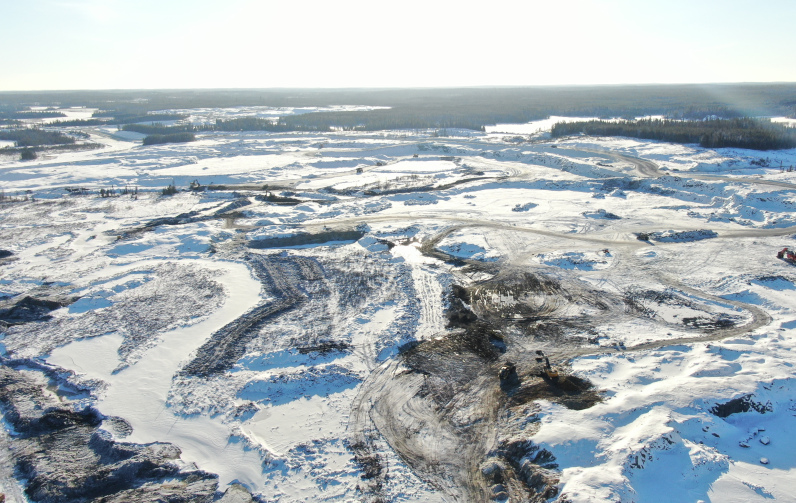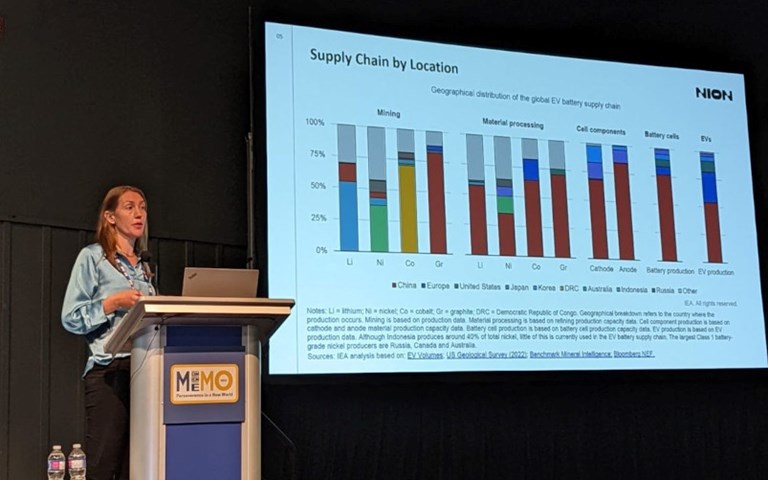Johnna Muinonen delivers her keynote speech at the MeMO 2022 Conference. Courtesy of Maintenance, Engineering/Mine Operators Conference.
To meet projected nickel demand, the world will need at least another 40 nickel mines turning out 38,000 tonnes per year by 2030, Johnna Muinonen, president of Dumont Nickel told those attending the keynote address at the Maintenance, Engineering/Mine Operators Conference in Sudbury.
Canada’s nickel resources puts it on good footing to potentially meet some of the needed production capacity, however, Muinonen made it clear that our store of raw materials answers only one of the many obstacles that stand between current output and anticipated demand.
“I do think Canada has a role to play and there's an exciting future there,” she said on the opening day of the two-day technical conference designed to engage with the technical and human resource issues facing the industry as it adapts to changes unique to the sector and across the world.
This country’s share of global nickel production has been shrinking over time as Indonesia has become a nickel-mining giant, but Muinonen argued the combination of Canada’s access to secure and clean energy, its regard for ESG, local expertise in mining the metal, supportive government policies and our proximity to United States, which has committed hundreds of billions of dollars to energy and climate change spending with some of that available to its free trade partners, gives Canada an opportunity.
To realize it, she said, there will need to be more processing capacity, more technical expertise and much better integration along the supply chain.
“You can’t say, ‘Okay, we're going to build a ton of nickel sulfate plants and we're going to sell it to somebody’. If you haven’t integrated downstream, the battery makers may turn around and tell you it is not to specification. The qualification process is extremely complex. Working with partners throughout the ecosystem is going to be really important.”
The technical program for this year’s MeMO conference that followed Muinonen’s keynote echoed her concern about the future of the mining workforce and included sessions on workforce strategy, culture and training.
Related: COM 2022 featured the latest in metallurgical innovations on the quest to eliminate greenhouse gas emissions
Jason Bubba, COO of the Sudbury-based technology and innovation center NORCAT detailed how the organization was using a combination of traditional approaches such as in-class theory and field work with virtual reality and simulations to improve and standardize the training process. Beyond the advantages of creating a better prepared workforce, Bubba said showing off the new tools they are using has the power to draw people into the industry. “We get them excited through technology.”
If the industry needs to find more workers, then the people doing the hiring need to rethink who are eligible candidates. J.C. Doyle, a diversity and inclusion specialist with the Ontario Disability Employment Network, explained to the audience that hiring Canadians with a disability – an estimated 6 million over the age of 15, with an unemployment rate of 41 per cent – is far less costly and far more valuable than employers understand.
Doyle, citing research from Accenture, noted disabled employees generally require accommodations that cost less than $500, stay in the job as long as and have equally good attendance as workers without disabilities. The research, said Doyle, also shows that “companies that include people with disabilities outperform those that don’t.”
The conference also served as a vehicle for the launch of the Mining Industry Human Resources Council and the Canadian Institute of Mining, Metallurgy and Petroleum We need mining. Mining needs you. Career Ambassador Program. The initiative is designed to introduce students and youth to industry professionals who, with the support of MiHR, can share the experiences, opportunities and benefits of working in mining.
“Through [the program], MiHR and CIM aim to positively impact youth perceptions of the industry by showcasing the many benefits of careers in mining, including financial rewards, working with cutting edge technology and the ability to make a positive difference to the industry and society,” said MiHR executive director Ryan Montpellier in the announcement of the program.
In the same news release, CIM CEO Angela Hamlyn explained, “launching the Career Ambassador Program at MeMO in Sudbury – a renowned mining jurisdiction – puts CIM and MiHR in the right place to help the industry address and meet these challenges now and in the future.”




